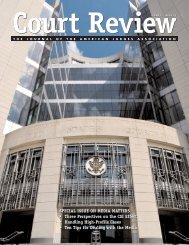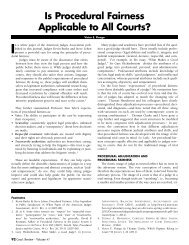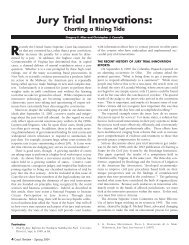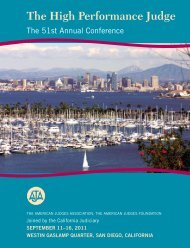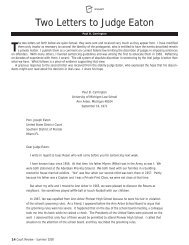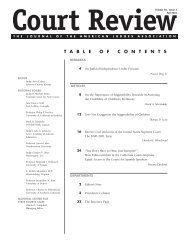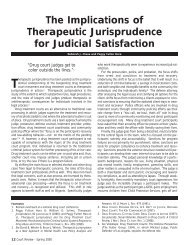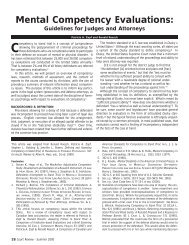Special Issue on Procedural Fairness - American Judges Association
Special Issue on Procedural Fairness - American Judges Association
Special Issue on Procedural Fairness - American Judges Association
- No tags were found...
Create successful ePaper yourself
Turn your PDF publications into a flip-book with our unique Google optimized e-Paper software.
or also because they are more familiar with the court’s typical procedures and thus do notfeel as lost during the process. 54An interesting study provides some insight. A number of federal appellate judgesreviewed police–citizen encounters raising Fourth Amendment issues. Half the judgesread about a search that was c<strong>on</strong>ducted fairly, with polite police who identified themselvesfrom the outset and who listened to the citizen’s side of the story; the other halfread about a search that was c<strong>on</strong>ducted without much procedural fairness, with rude andhostile officers who didn’t initially identify themselves and who never gave the citizen achance to explain the situati<strong>on</strong>. While judges recognized differences in the police behavior,those differences made no difference in the way the judges decided the cases underthe Fourth Amendment. 55 <strong>Judges</strong> are trained to focus <strong>on</strong> the relevant legal issues and toprovide fair outcomes. In the public’s eye, however, disrespect and blatant bias are certainways to create dissatisfacti<strong>on</strong> and to be perceived as procedurally unfair. This diss<strong>on</strong>ancebetween the expectati<strong>on</strong>s of judges and the public suggests “that the meaning offairness am<strong>on</strong>g judges is c<strong>on</strong>siderably different . . . [and] outcome c<strong>on</strong>cerns had a greaterinfluence am<strong>on</strong>g judges than the procedural criteria of trust, neutrality, and standing”that c<strong>on</strong>stitute the public’s c<strong>on</strong>cepti<strong>on</strong> of procedural fairness. 56This difference may be more than just a little problematic since percepti<strong>on</strong>s of proceduralfairness have a substantial impact <strong>on</strong> both satisfacti<strong>on</strong> and compliance for the public.However, this is not a difference that affects <strong>on</strong>ly judges and litigants; this is perhaps theinherent diss<strong>on</strong>ance that exists between all decisi<strong>on</strong> makers and decisi<strong>on</strong> recipients.Social psychology professor Larry Heuer found generally in an experiment involving collegestudents, who were tasked randomly either to be the decisi<strong>on</strong> maker or the decisi<strong>on</strong>recipient, that “decisi<strong>on</strong> recipients [were] oriented primarily to procedural informati<strong>on</strong>,while decisi<strong>on</strong> makers [were] oriented primarily to societal benefits,” 57 which are generallythe outcomes. Decisi<strong>on</strong> makers, or judges, who are aware of these differences canbetter cater their remarks to the needs and expectati<strong>on</strong>s of litigants and the public so asto ensure better satisfacti<strong>on</strong> and compliance.The mediati<strong>on</strong> process is <strong>on</strong>e attempt to bridge this expectati<strong>on</strong> divide by meeting theneeds of both groups. 58 <strong>Judges</strong>, who were focusing up<strong>on</strong> achieving legal soluti<strong>on</strong>s, historicallyhave employed a variety of types of procedures to meet those ends, including settlementc<strong>on</strong>ferences. But litigants were often excluded from key moments during suchc<strong>on</strong>ferences. When lawyers emerged from a back room and announced to their clientsthat they had achieved a good outcome, the lawyers were surprised to find that theirclients were often angry instead of pleased. From a traditi<strong>on</strong>al point of view, lawyers andjudges were c<strong>on</strong>fused. They had come up<strong>on</strong> a legally appropriate outcome and thoughtthat they had d<strong>on</strong>e their job. But the parties had no voice and could not see that the procedureswere neutral because there was no transparency in the process. They did not seeany evidence that their c<strong>on</strong>cerns were being taken seriously because they had minimal54. Rottman 2005, supra note 21, at 11, 18.55. Heuer, supra note 34, at 217.56. Id57. Id. at 218.58. Tom R. Tyler, The Quality of Dispute Resoluti<strong>on</strong> Procedures andOutcomes: Measurement Problems and Possibilities, 66 DEN. U. L.REV. 419 (1989).Court Review - Volume 44 15



